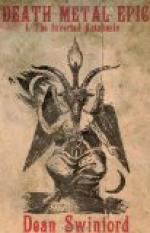In the Langobardian cycle[25] also is the tale of “Rother,” supposed to be Charlemagne’s grandfather, one of the court epics of the Lombard cycle. In King Rother we have the abduction by Rother of the emperor’s daughter, her recovery by her father, and Rother’s pursuit and final reconquest of his wife. The next epic in the cycle, “Otnit,” related the marriage of this king to a heathen princess, her father’s gift of dragon’s eggs, and the hatching of these monsters, which ultimately cause the death of Otnit and infest Teutonic lands with their progeny. Then come the legends of Hug-Dietrich and Wolf-Dietrich, which continue the Lombard cycle and pursue the adventures of Otnit to his death.
The legend of Herzog Ernst is still popular, and relates how a duke of Bavaria once made a pilgrimage to Jerusalem and lived through endless thrilling adventures on the way.
The greatest of all the German epics is undoubtedly the Nibelungenlied,—of which we give a synopsis,—which is often termed the Iliad of Germany, while “Gudrun” is considered its Odyssey. This folk epic relates how Hagan, son of a king, was carried off at seven years of age by a griffin. But, before the monster or its young could devour him, the sturdy child effected his escape into the wilderness, where he grew up with chance-found companions. Rescued finally by a passing ship, these young people are threatened with slavery, but spared so sad a fate thanks to Hagan’s courage. Hagan now returns home, becomes king, and has a child, whose daughter Gudrun is carried away from father and lover by a prince of Zealand. On his way home, the kidnapper is overtaken by his pursuers and wages a terrible battle on the Wuelpensand, wherein he proves victorious. But the kidnapper cannot induce Gudrun to accept his attentions, although he tries hard to win her love. His mother, exasperated by this resistance finally undertakes to force Gudrun to submit by dint of hardships, and even sends her out barefoot in the snow to do the family washing. While thus engaged, Gudrun and her faithful companion are discovered by the princess’ brother and lover, who arrange the dramatic rescue of the damsels, whom they marry.[26]
Next in order come the philosophic epics of Wolfram von Eschenbach, including the immortal Parzifal—which has been used by Tennyson and Wagner in their poems and opera—and the poetic tales of Gottfried of Strassburg, whose Tristan und Isolde, though unfinished, is a fine piece of work. Hartmann von der Aue is author of Erek und Enide,—the subject of Tennyson’s poem,—of Der arme Heinrich,—which served as foundation for Longfellow’s Golden Legend,—and of Iwein or the Knight with the Lion.




